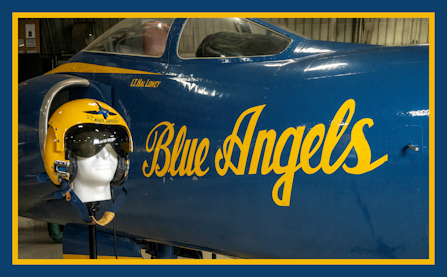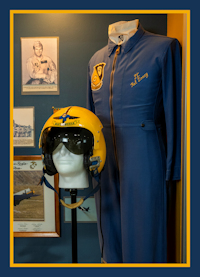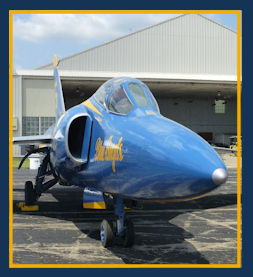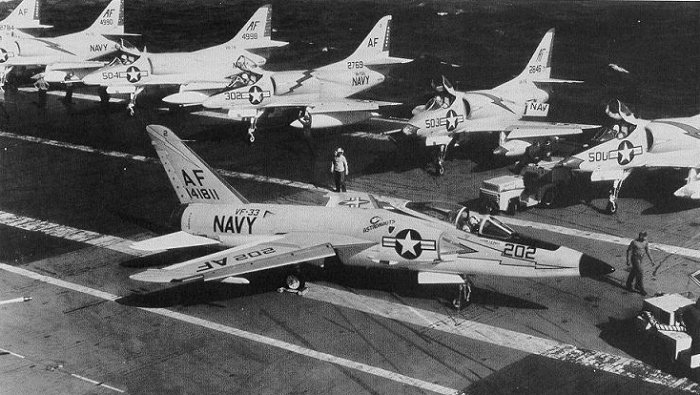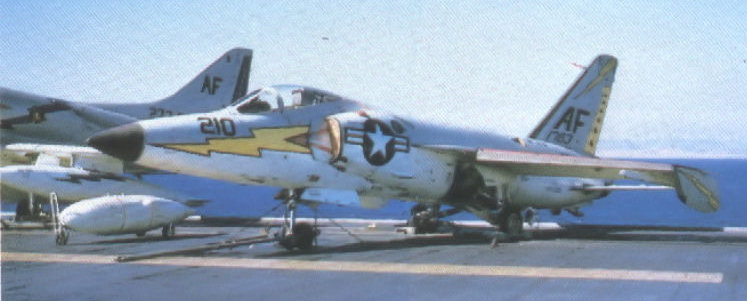The Navy accepted BuNo 141811 at Bethpage, Long Island, New York on February 4, 1958.
The US Navy Blue Angels flew this aircraft during their 1968 season. Its solo pilot was Navy Lieutenant Hal Loney. The jetís last performance was at an airshow in Olathe, Kansas. It was then transferred to University of Kansasís Aerospace Engineering Department. Combat Air Museum acquired the Tiger from KU on Conditional Transfer through the Federal Surplus Property program in June 1980. The jet was transported from Lawrence, Kansas to Topeka under an Army National Guard CH-54 Tarhe (Skycrane). After its arrival at CAM, the jet was given a new coat of Blue Angels colors and markings.
The Tiger was the Navy’s first supersonic fighter. A key design feature was the waisting of the fuselage just behind the main wings (known as area-rule). Viewed from above, the shape looks like an old glass soda bottle. This feature reduced drag at supersonic speeds. The folding wing tips were necessary for storage aboard aircraft carriers. The small tubing that runs along the left side of the aircraft delivered smoke-generating oil into the exhaust of the jet engine for airshow performances.
Some 200 Tigers were built and served in six US Navy Fighter Squadrons. The Navy accepted this aircraft on April 2, 1958. It flew with Fighter Squadron VF-33 from the aircraft carrier USS INTREPID on various cruises from 1958-1961. Tigers began to phase out of front-line use in 1959. This Tiger was in and out of Navy storage facilities from 1961-1965, then served with Training Squadron VT-26 at Chase Field near Beeville, Texas. In 1962, the Tiger’s designation was changed from F11F-1 to F-11A. The aircraft briefly entered storage again in 1967 until flown by the Blue Angels.
Historical Note: During the F11F flight test program, on September 21, 1956, Grumman test pilot Tom Attridge shot himself down by flying into shells he had fired only moments before while in supersonic flight. The press used the incident to dramatize the speeds that new jets were capable of flying.
This aircraft is on Conditional Transfer to Combat Air Museum from the Kansas State Agency for Federal Surplus Property and the General Services Administration.
Assignments: |
|
2/11–2/15/58 |
Assigned to FASTRON 5. |
2/15–3/19/61 |
Assigned to VF-33, NAS Oceana, VA, and deployed aboard the USS INTREPID. |
3/61–2/24/62 |
In storage at Litchfield Park, AZ. |
2/24–4/26/62 |
With O&R BUWEPS at Cherry Point, NC. |
4/26/62–2/18/65 |
In storage at Litchfield Park, AZ. |
2/18–4/14/65 |
Returned to O&R BUWEPS at Cherry Point, NC. |
4/14–5/2/65 |
With TRARON 23, at Kingsville, TX. |
5/2/65 |
Returned to O&R BUWEPS at Cherry Point, NC. |
5/65–7/65 |
Returned to TRARON 23, at Kingsville, TX. |
7/65–11/22/66 |
With TRATON 26, Chase Field, TX. |
11/22/66–1/3/69 |
Assigned to NABTC at Pensacola, FL. The US Navy Blue Angels flew this aircraft during their 1968 season. Its solo pilot was Navy Lieutenant Hal Loney. |
1/3/69–5/69 |
Located at NAS Olathe, KS. |
5/69 |
The University of Kansas (KU) acquired 141811. Used in their Aerospace Engineering Department, at the Lawrence Municipal Airport. |
6/80 |
Transferred to Combat Air Museum. Airlifted by a CH-54 Tarhe helicopter from Lawrence Airport to Forbes Field. |
TECHNICAL NOTES: |
|
Manufacturer: |
Grumman Aircraft Engineering Corporation, Bethpage, Long Island, New York. |
Type first flown: |
July 30, 1954. Production completed in December 1958 |
Type: |
Day fighter. |
Crew: |
Pilot only. |
Power plant: |
One 7,540 lb. s.t. (33.5kN) Wright J65-W-18 turbojet. |
Dimensions: |
Span: 31 ft 7½ in (9.6m) |
Length: |
46 ft 11¼ in (14.3m) |
Height: |
13 ft 2¾ in (4.0m) |
Wing area: |
250sq ft (23.2sq m) |
Weights: |
Empty: 13,428 lbs. (6,091kg) Gross, 22,160 lbs. (10,052kg) |
Performance: |
Max speed: 750 mph (1,210km/hr) @sea level |
Cruising speed: |
577mph (931km/hr) @38,000 ft (11,582 m) |
Service ceiling: |
41,900 ft (12,771 m) |
Range: |
1,270 miles (2,048 km). |
Armanent: |
Four fixed forward-firing 20 mm guns; four underwing Sidewinder 1A or 1C air-to-air missiles |
Serial number: |
US Navy BuNo. 141811 |
|




